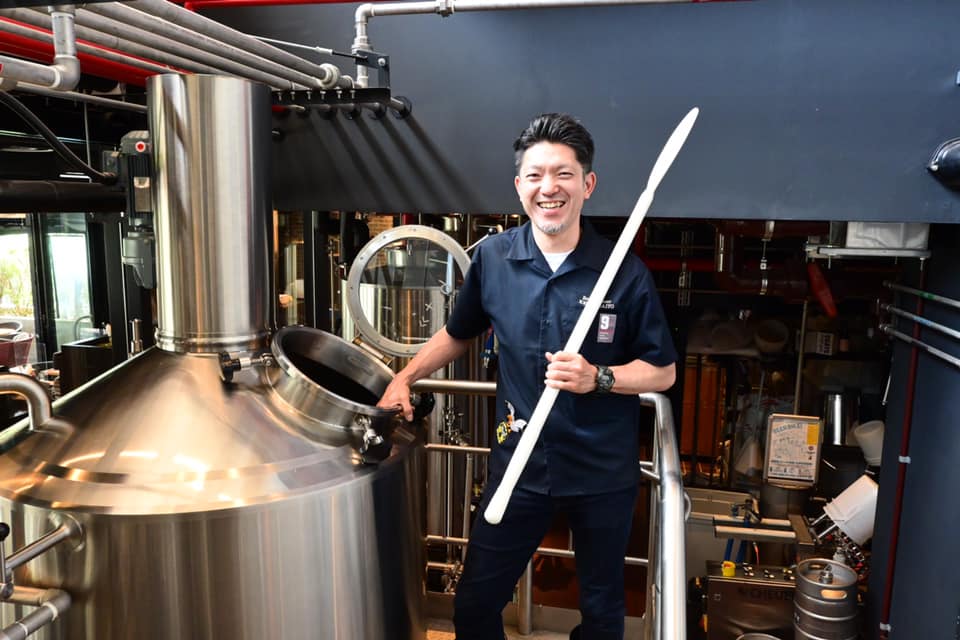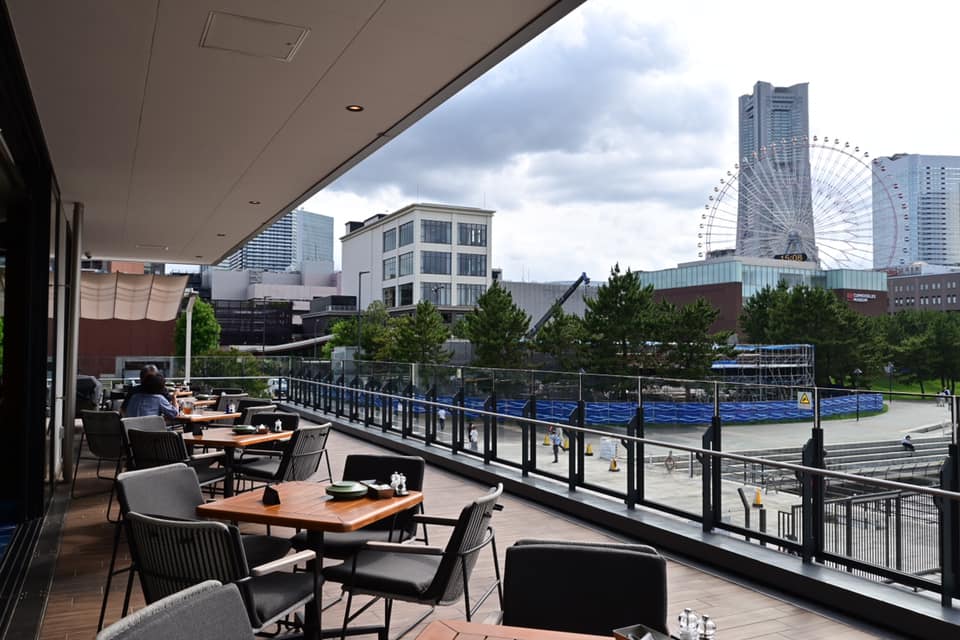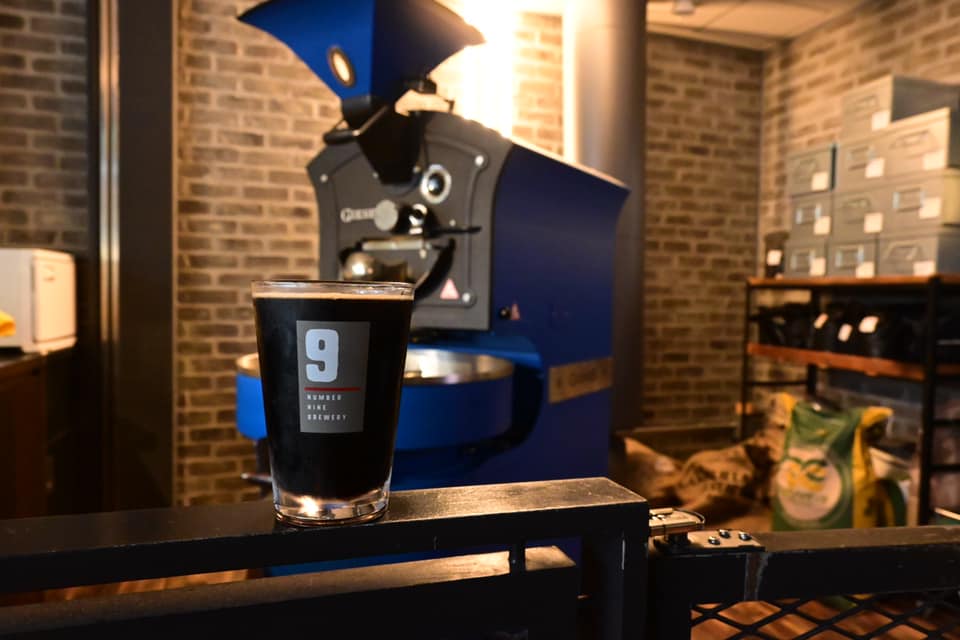If at first you don’t succeed, try, try, and try again. The proverb exemplifies the brewing career of Kengo Saito, now at the helm at Number Nine Brewery in Yokohama. Saito’s fifteen-year journey was one of persistence that took a detour through Oceania before returning him to the Land of the Rising Sun, where he eventually landed his current head brewer role.
Saito is sunny in demeanor, talkative, and animated. Clearly influenced by his time abroad, he shows no embarrassment when employing his imperfect English (“Kiwi Japanglish” in his words) to communicate. The interview rolls easily into its second hour with little pause in the conversation and I get the sense that if he didn’t have work to finish, we could’ve sat at the bar all day chatting over beers.
Saito’s story begins in the town of Samukawa, Kanagawa, where he was born and raised. After attending trade school to study business administration, in 1994 he took a job at cookie maker Aunt Stella’s facility in neighboring Chigasaki. Saito admits that the main reason he had the company on his radar was that he could talk his way into a job. He concedes with a grin, “They only required an interview, not a paper test. I’m good at talking, but not at test taking, so that’s basically why I chose it.” He spent a decade there–eight as shop manager–but in the end didn’t find making cookies to be especially engaging.
Looking for a career change, he began searching for a more stimulating job. He learned that another Chigasaki company, Kumazawa Shuzo, makers of Tensei sake and Shonan Beer, was hiring. Saito thought, “Hmmm, a brewery, now that sounds interesting for sure!” In the spring of 2004 he applied and got a job as head of shipping and receiving. At the time, he wasn’t much of a beer drinker and also a bit of a lightweight, by his own admission. Given that, his introduction to craft beer was an odd one–Shonan’s Imperial Stout. The bold brew was nothing like any beer he knew at the time and inspired him to take an interest in brewing. Unfortunately for him, a young man by the name of Takashi Tsutsui had recently been selected to fill the only opening on the brew team. As many in the Japanese craft beer scene know, Tsutsui went on to become an exceedingly accomplished brewer and has been Shonan’s top dog for about a decade and a half now.
A somewhat impatient Satio had gotten it into his head that he had to become a brewer sooner rather than later. Instead of waiting for a position to open up, he went on the job hunt again. At Harvestmoon in Chiba, he found a part-time position that would allow him to learn the ins and outs of brewing under the tutelage of veterans Tomoko Sonoda and Masatoki Sakurai. Six months into his stint he was offered full-time employment. Sonoda was frequently dispatched to events all over the country, allowing Saito to jump into the brewing often. It was an excellent learning experience for him and he still retains a strong connection to this day.
While at Harvestmoon, Saito got another idea in his head that he couldn’t shake. His sister had moved to Queenstown, New Zealand, and he visited her from time to time. Exposed to a new and different beer culture, he developed an impulsive urge to brew in New Zealand. The desire became so strong that after ten years at Harvest Moon, he decided to quit and pursue this new dream.
At the time, he couldn’t obtain a working holiday visa because he was over thirty. He opted to enroll in an English program there and go on a student visa. While attending school, he scoured the countryside seeking employment at breweries. His goal was to live in Wellington, where he hoped to get a chance to brew at Garage Project (see JBT23). He didn’t have connections there, or anywhere for that matter, so he just popped in unexpectedly, resume in hand. Garage Project didn’t work out, but he found a small place called Fork & Brewer where he eventually had some success.
The head brewer was Kelly Ryan, a Brit who had been the brewing manager at Thornbridge. It turned out that he was relatively famous in brewing circles. Saito persistently bugged Ryan to hire him, but he wasn’t able to convince him, so he offered his time for free in exchange for the experience. Ryan acquiesced. Says Saito, “He would let me know when he had a brew day and I would show up. Without a word from him, I went right to work cleaning and helped with the prep work. After doing that many times, he asked me to join him in the brewing. I wasn’t getting paid, but at least he bought me delicious burgers for lunch.”
Saito went to New Zealand without much English ability, but by being fully immersed, studying at school, and picking up more terminology in the brewery, his communication skills were quickly improving. As he already knew his way around a brewery, his language skills proved to be sufficient for the job. Ryan was impressed with his work ethic and actually needed a hand in the brewery. After ten months of volunteer work, Ryan decided he wanted to take Saito on board as a full-time employee. But, as Saito explains it, foreign workers could only be hired if no qualified Kiwi applied for the position. Ryan quietly put up a help wanted notice, but didn’t make any effort to publicize it, in hopes that it would fly under the radar. To Saito’s dismay, word got out quickly due to Ryan’s celebrity, and a significant number of competent brewers applied. His chance of getting a work visa soon evaporated.
At this point he had used up all his savings (and had completed his English studies), but couldn’t find a brewery to sponsor a visa. He was forced to leave Wellington to crash at his sister’s place in Queenstown. While there he went from brewery to brewery, resume in hand, begging for an interview. Saito fondly reminisces with a grin, “Ryan was very supportive of me and when he was asked by brewers I visited, ‘Do you really know this wacky Japanese guy that came in looking for a job?’ He would reply, ‘Kengo? Yeah, that guy worked for me before’, and put in a good word for me. ‘Kengo the wacky Japanese guy’ became somewhat well known among the brewing community in New Zealand. I later learned that there were many people that wanted to work for Ryan, due to his fame. I realized how lucky I had been to have gotten the chance. When I look back, I think that it was fortunate that I went there with a solid knowledge of brewing and proper sanitation.”
While Saito was scouring the countryside for work, a Kiwi who was running a brewery in Australia was planning on scaling up, but lacked a head brewer. Home on holiday, he visited some of his brewing friends inquiring if they knew someone that could fill the role. One informed him, “There’s this wacky Japanese guy who is looking for a brewing position. He worked for Ryan and is hard-working.” He gave Saito a call and the two connected.
Saito confesses that he didn’t really want to go to Australia, but knew that if he could get a visa there as a brewer, it would be easier to get approval for a visa in New Zealand. With that in mind, he journeyed to Australia to give it a shot. He spent two months working at Moody Cow Brewery in the small port city of Bunbury on Australia’s predominantly rural west coast. Relates Saito, “It’s really in the countryside and focused on more old-school brews, not the hoppy stuff I was accustomed to. But the owner told me I could make what I liked and would help me get a visa, so of course, I took the job.”
He returned to Japan to initiate the paperwork for his work visa. On returning he received the tragic news that his mother had been diagnosed with cancer. His only other sibling was in New Zealand and his father was himself in poor health. He was left with little choice but to abandon his plan to work in Australia to care for his ailing parents. Now unemployed, he started searching for a head brewer position locally.
In the meantime he asked his old colleague Sonoda if she could provide some part-time work for a while. “A while” turned out to be three years. During that time he connected with a number of places that showed promise, but fell through for one reason or another. For one brewpub, he worked on quotes for materials and helped prepare for its opening only to see its permit rejected due to structural issues. He found another position in Fukushima and left Harvestmoon to help that operation get started, but it proceeded so slowly that he lost hope that it would ever open and he left dejectedly.
It was then that he heard that restaurant group Huge Co. was going to be opening a brewery in Yokohama. He applied and was interviewed directly by the president. Saito, admittedly still somewhat of a lightweight, expressed a desire to produce lighter bodied beers with alcohol content on the low side. This meshed well with the president’s wish to serve brews at many of the company’s thirty or so restaurants. The concept that both men envisioned was beers that could complement cuisine, not interfere with its flavor. Seeing that their visions aligned and taking into account Saito’s years of experience, the president hired him almost immediately. It was a long journey, but in October of 2019, Saito finally had his head brewer’s position.
Number Nine brewery occupies space in Quays Pacific Grill, which also features a gin distillery and coffee roastery. The flashy brewery is visible in its entirety from the restaurant through large windows. The bar and grill takes full advantage of its favorable location at the front of the Yokohama Hammerhead cruise ship terminal complex. Its position on the first and second floors offers ample outside dining and a sweeping view of the high-rise Minato Mirai district along the waterfront. The first floor patio sits along likely the city’s most popular pedestrian thoroughfare, which connects Minato Mirai to the historic Red Brick Warehouse, Osanbashi Pier (site of Japan Brewers Cup and BeerFes Yokohama), and Yamashita Park (the usual venue for Belgian Beer Weekend Yokohama) along 2.5km of oceanfront. Yokohama Hammerhead opened in the fall of 2019. Despite the fact that COVID almost immediately put an end to all cruises and the presence of international travelers, the complex has proven to be extremely popular with locals, thanks in part to that steady stream of pedestrian traffic. The old wharf that became Hammerhead contained docks #8 and #9, and hence the origin of the brewery’s name (the gin distillery taking the name Number Eight).
Though you can take a seat at the bar, most of the patrons are there for a dining experience–many of them unfamiliar with craft beer. In line with Saito’s philosophy, most of the beer on tap is 5%ABV or less. That means well-balanced, lighter-bodied, aromatic brews. Saito sees a trend in the world beer market toward these more sessionable beers, something that obviously jives with his personal philosophy. He believes it makes good business sense, too. It’s a lot easier for a customer to reach for another 3% session IPA than a hazy 8% DIPA.
Currently Number Nine’s regular lineup is comprised of Super Session IPA (1.2%), Hammerhead Ale (3.8%), Quays Pilsner (4.1%), Hazy IPA (5.1%), and Coffee Stout (5.0%). On top of that Saito brews two to three seasonals to service the bar’s eight taps. During my visit, I started with the pilsner, which was light and refreshing, with a nice malt/hop balance–precisely what Saito professes to aim for. Of the standards, I also tried the Coffee Stout, which is made with coffee beans (added to the tank post fermentation, similarly to dry hopping) roasted on site at the neighboring Hammerhead Roastery. It had a slight spicy bite and the flavor of the roasted beans stood out in the aroma and velvety aftertaste. Of special interest to me was the seasonal Chipotle IPA (5.5%). The pleasant hot pepper bite wasn’t overpowering but neither was it weak. You feel the tang nasally and on its way down, but it doesn’t smother the mildly fruity IPA base. I’ve become a big fan of this one. Saito makes it clear that he isn’t against high-alcohol beers. He still remembers that Shonan Imperial Stout. For the brewery’s two-year anniversary in October he is making a special 9% (celebrating the brewery name) Imperial Golden Ale.
The industrious Saito does everything in the brewery himself: brewing, kegging, desk work, tax office interaction, ordering materials, prep, and cleaning. He usually brews a double batch once a week on the 500L system to feed five 1000L tanks. Almost all of the restaurants serviced by Number Nine are located in Kanto, so the pandemic’s alcohol restrictions have hit especially hard. Like many breweries in the time of COVID, having canning capability has become key and plans are underway to make that a reality. Saito had been outsourcing bottling to Yokohama Beer and selling at the Hammerhead 7-11, but they became too busy with their own packaging to keep up. Waiting for relaxed restrictions and the arrival of canning equipment is about all he can hope for at this point.
After a prolonged journey to find almost precisely the situation he had sought, do you doubt that he’ll persevere? Saito has proven to be upbeat and resilient. If persistence is wacky, then we all surely could benefit from being a little bit quirky. It would seem that wacky Japanese guy is a whole lot more practical upon closer inspection.
This article was published in Japan Beer Times # () and is among the limited content available online. Order your copy through our online shop or download the digital version from the iTunes store to access the full contents of this issue.






